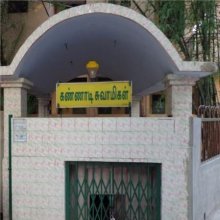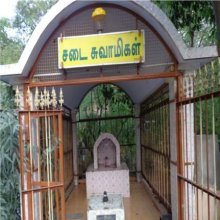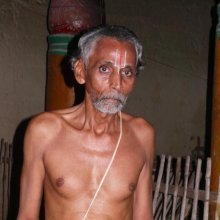Kanati, Kanaṭī, Kaṉati, Kāṇaṭi, Kaṇṇāṭi, Kaṇṇaṭi: 6 definitions
Introduction:
Kanati means something in Hinduism, Sanskrit, Tamil. If you want to know the exact meaning, history, etymology or English translation of this term then check out the descriptions on this page. Add your comment or reference to a book if you want to contribute to this summary article.
Images (photo gallery)
Languages of India and abroad
Sanskrit dictionary
Source: DDSA: The practical Sanskrit-English dictionaryKanaṭī (कनटी).—Red arsenic.
Source: Cologne Digital Sanskrit Dictionaries: Monier-Williams Sanskrit-English DictionaryKanaṭī (कनटी):—f. red arsenic (= kunaṭī).
[Sanskrit to German]
Sanskrit, also spelled संस्कृतम् (saṃskṛtam), is an ancient language of India commonly seen as the grandmother of the Indo-European language family (even English!). Closely allied with Prakrit and Pali, Sanskrit is more exhaustive in both grammar and terms and has the most extensive collection of literature in the world, greatly surpassing its sister-languages Greek and Latin.
Kannada-English dictionary
Source: Alar: Kannada-English corpusKaṇati (ಕಣತಿ):—[noun] a woman, belonging to ಕೊರವ [korava] caste, who is supposed to predict as by the influence of divine guidance; a soothsayer.
--- OR ---
Kanāti (ಕನಾತಿ):—[noun] a hard stroke with a hand or weapon; a blow.
Kannada is a Dravidian language (as opposed to the Indo-European language family) mainly spoken in the southwestern region of India.
Tamil dictionary
Source: DDSA: University of Madras: Tamil LexiconKaṇṇaṭi (கண்ணடி) [kaṇṇaṭittal] [kaṇ-aṭi] intransitive verb < கண் [kan] +. To wink significantly; கண்சாடைசெய்தல். [kansadaiseythal.]
--- OR ---
Kaṇṇaṭi (கண்ணடி) [kaṇ-aṭi] noun < idem. + ஆடு-. [adu-.] [K. Travancore usage kannaḍi.] See கண்ணாடி. நின்வனப்பிற் கெல்லாங் கண்ணடி [kannadi. ninvanappir kellang kannadi] (சீவகசிந்தாமணி [sivagasindamani] 629).
--- OR ---
Kaṇṇāṭi (கண்ணாடி) [kaṇ-āṭi] noun < idem. + ஆடு-. [adu-.] [Malayalam: kaṇṇāḍi.]
1. Mirror made of burnished gold or of any polished metal; உருவம் பிரதிவிம்பிக்கும் படிமக்கலம். [uruvam pirathivimbikkum padimakkalam.] (சீவகசிந்தாமணி [sivagasindamani] 2327.)
2. Glass things; கண் ணாடியாலான பொருள். [kan nadiyalana porul.]
3. Looking glass; முகம் பார்க்கும் கண்ணாடி. [mugam parkkum kannadi.]
4. Spectacles; மூக்குக்கண் ணாடி. [mukkukkan nadi.] Colloq.
--- OR ---
Kaṉati (கனதி) noun < ghana-tā.
1. Heaviness, ponderosity, gravity; பாரம். [param.]
2. Thickness; பருமை. [parumai.] (W.)
3. Pride, haughtiness; இறு மாப்பு. [iru mappu.] (W.)
--- OR ---
Kāṇaṭi (காணடி) [kāṇaṭittal] [kāṇ-aṭi] transitive verb < காண [kananul] + அடி-. [adi-.] To lose; போக்கடித்தல். [pokkadithal.] Local usage
--- OR ---
Kaṇṇāṭi (கண்ணாடி) [kaṇ-āṭi] noun < கண் [kan] +. Glow-worm; மின்மினி. (பச்சிலைமூலிகை அகராதி) [minmini. (pachilaimuligai agarathi)]
Tamil is an ancient language of India from the Dravidian family spoken by roughly 250 million people mainly in southern India and Sri Lanka.
See also (Relevant definitions)
Partial matches: Kan, Adi, Ati.
Starts with: Kanatina, Kanatipam, Kanatira, Kanatiraka.
Ends with: Akanati, Caparakanati, Chakanati, Ekanati, Ekkanati, Makanati, Mekanati, Narakanati, Natakanati, Nirkkanati, Piravakanati, Sukanati, Takkanati, Thikanati, Tikanati.
Full-text (+40): Kan, Kanadi, Kannati, Cinikkannati, Kannatikkatavu, Mukkukkannati, Kuruttukkannati, Nilaikkannati, Kannatipputaiyan, Nirkkanati, Cikkana, Kannadi yele, Uruvankatti, Curiya-kantakannati, Munnaikkanam, Kannatittara, Tura-tirushtikannati, Kannatikkuttan, Putakkannati, Kattariviriyan.
Relevant text
Search found 2 books and stories containing Kanati, Kanaṭī, Kaṉati, Kāṇaṭi, Kaṇṇāṭi, Kaṇṇaṭi, Kaṇati, Kanāti, Kāṇ-aṭi, Kan-ati, Kaṇ-āṭi, Kannati, Kaṇ-aṭi, Kanathi, Kanadi, Kanadhi, Kaanadi, Kannadi, Kannaadi, Kan-adi; (plurals include: Kanatis, Kanaṭīs, Kaṉatis, Kāṇaṭis, Kaṇṇāṭis, Kaṇṇaṭis, Kaṇatis, Kanātis, aṭis, atis, āṭis, Kannatis, Kanathis, Kanadis, Kanadhis, Kaanadis, Kannadis, Kannaadis, adis). You can also click to the full overview containing English textual excerpts. Below are direct links for the most relevant articles:
The backdrop of the Srikanthacarita and the Mankhakosa (by Dhrubajit Sarma)
Part 3 - Structure of the Maṅkhakośa contents < [Chapter V - The Maṅkhakośa]
Kamashastra Discourse (Life in Ancient India) (by Nidheesh Kannan B.)
7. Concept of Kāma (Introduction) < [Chapter 4 - Positioning Kāma among the Puruṣārthas]


